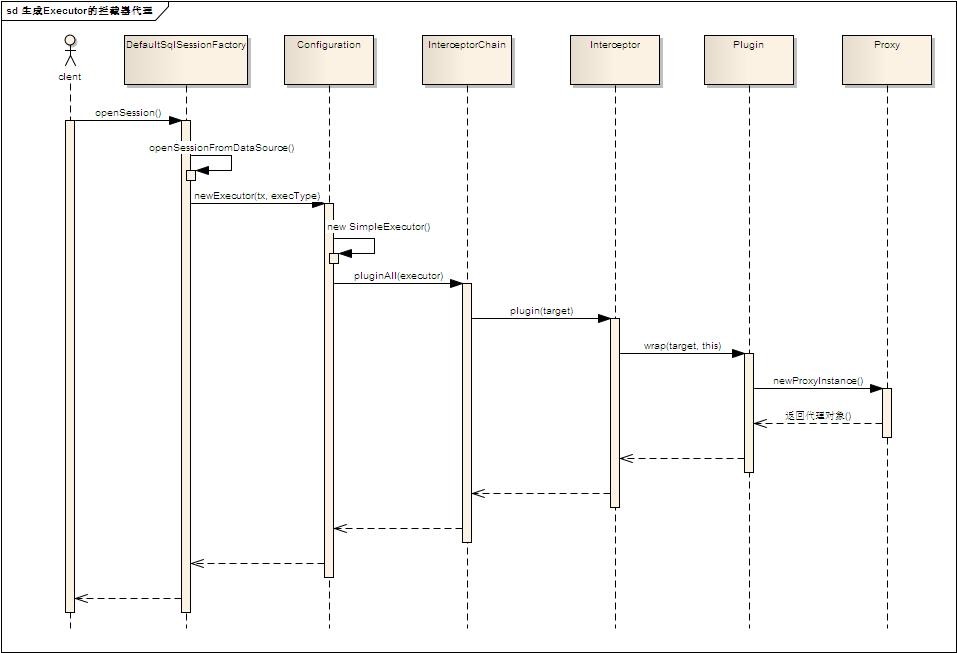先看一下mybatis拦截器的用法和用途,先用为ibatis3提供基于方言(Dialect)的分页查询的例子来看一下吧!源码:
@Intercepts({@Signature(
type= Executor.class,
method = "query",
args = {MappedStatement.class, Object.class, RowBounds.class, ResultHandler.class})})
public class OffsetLimitInterceptor implements Interceptor{
private static int MAPPED_STATEMENT_INDEX = 0;
private static int PARAMETER_INDEX = 1;
private static int ROWBOUNDS_INDEX = 2;
private Dialect dialect;
public Object intercept(Invocation invocation) throws Throwable {
processIntercept(invocation.getArgs());
return invocation.proceed();
}
private void processIntercept(final Object[] queryArgs) {
//queryArgs = query(MappedStatement ms, Object parameter, RowBounds rowBounds, ResultHandler resultHandler)
MappedStatement ms = (MappedStatement)queryArgs[MAPPED_STATEMENT_INDEX];
Object parameter = queryArgs[PARAMETER_INDEX];
final RowBounds rowBounds = (RowBounds)queryArgs[ROWBOUNDS_INDEX];
int offset = rowBounds.getOffset();
int limit = rowBounds.getLimit();
if(dialect.supportsLimit() && (offset != RowBounds.NO_ROW_OFFSET || limit != RowBounds.NO_ROW_LIMIT)) {
BoundSql boundSql = ms.getBoundSql(parameter);
String sql = boundSql.getSql().trim();
if (dialect.supportsLimitOffset()) {
sql = dialect.getLimitString(sql, offset, limit);
offset = RowBounds.NO_ROW_OFFSET;
} else {
sql = dialect.getLimitString(sql, 0, limit);
}
limit = RowBounds.NO_ROW_LIMIT;
queryArgs[ROWBOUNDS_INDEX] = new RowBounds(offset,limit);
BoundSql newBoundSql = new BoundSql(ms.getConfiguration(),sql, boundSql.getParameterMappings(), boundSql.getParameterObject());
MappedStatement newMs = copyFromMappedStatement(ms, new BoundSqlSqlSource(newBoundSql));
queryArgs[MAPPED_STATEMENT_INDEX] = newMs;
}
}
//see: MapperBuilderAssistant
private MappedStatement copyFromMappedStatement(MappedStatement ms,SqlSource newSqlSource) {
Builder builder = new MappedStatement.Builder(ms.getConfiguration(),ms.getId(),newSqlSource,ms.getSqlCommandType());
builder.resource(ms.getResource());
builder.fetchSize(ms.getFetchSize());
builder.statementType(ms.getStatementType());
builder.keyGenerator(ms.getKeyGenerator());
builder.keyProperty(ms.getKeyProperty());
//setStatementTimeout()
builder.timeout(ms.getTimeout());
//setStatementResultMap()
builder.parameterMap(ms.getParameterMap());
//setStatementResultMap()
builder.resultMaps(ms.getResultMaps());
builder.resultSetType(ms.getResultSetType());
//setStatementCache()
builder.cache(ms.getCache());
builder.flushCacheRequired(ms.isFlushCacheRequired());
builder.useCache(ms.isUseCache());
return builder.build();
}
public Object plugin(Object target) {
return Plugin.wrap(target, this);
}
public void setProperties(Properties properties) {
String dialectClass = properties.getProperty("dialectClass");
try {
dialect = (Dialect)Class.forName(dialectClass).newInstance();
} catch (Exception e) {
throw new IllegalArgumentException(
"cannot create dialect instance by dialectClass:"
+ dialectClass, e);
}
}
public static class BoundSqlSqlSource implements SqlSource {
private BoundSql boundSql;
public BoundSqlSqlSource(BoundSql boundSql) {
this.boundSql = boundSql;
}
public BoundSql getBoundSql(Object parameterObject) {
return boundSql;
}
}
}
注解Intercepts表示该类被用作拦截器,@Signature(type= Executor.class, method = "query",
args = {MappedStatement.class, Object.class, RowBounds.class, ResultHandler.class})用来表示拦截那个类得那个方法,拦截器可用于Executor,ParameterHandler,ResultSetHandler和StatementHandler这些类上。
我们看看这个拦截器是怎么拦截Executor的qurey方法的。先看生成Executor对象的过程:
我们从这个序列图中可以清晰的看出,我们最后得到的Executor是一个代理对象。返回的这个Executor的代理对象是将Plugin作为调用处理器的,我们看一下Plugin的invoke方法:
public Object invoke(Object proxy, Method method, Object[] args) throws Throwable {
try {
Set<Method> methods = signatureMap.get(method.getDeclaringClass());
if (methods != null && methods.contains(method)) {
return interceptor.intercept(new Invocation(target, method, args));
}
return method.invoke(target, args);
} catch (Exception e) {
throw ExceptionUtil.unwrapThrowable(e);
}
}
这个方法中需要提的就是signatureMap,我们看看这个signatureMap是怎么取得的,我们看到是从wrap方法中通过getSignatureMap(interceptor)得到的,getSignatureMap方法源码:
private static Map<Class<?>, Set<Method>> getSignatureMap(Interceptor interceptor) {
Signature[] sigs = interceptor.getClass().getAnnotation(Intercepts.class).value();
Map<Class<?>, Set<Method>> signatureMap = new HashMap<Class<?>, Set<Method>>();
for (Signature sig : sigs) {
Set<Method> methods = signatureMap.get(sig.type());
if (methods == null) {
methods = new HashSet<Method>();
signatureMap.put(sig.type(), methods);
}
try {
Method method = sig.type().getMethod(sig.method(), sig.args());
methods.add(method);
} catch (NoSuchMethodException e) {
throw new PluginException("Could not find method on " + sig.type() + " named " + sig.method() + ". Cause: " + e, e);
}
}
return signatureMap;
}
这个方法就是解析各个迭代器的标注,得到一个以被拦截的对象为key,以被拦截的方法集为值得value的Map。从上面这些源码我们可以了解,mybatis是将plugin已经做方法调用处理器,将目标对象一层层的做代理,在执行的时候判断方法是否在signatureMap中注册(也就是@Signature( type= Executor.class, method = "query",
args = {MappedStatement.class, Object.class, RowBounds.class, ResultHandler.class}))标注了没有),如果注册了就执行拦截器中的intercept方法。
@Intercepts({@Signature(
type= Executor.class,
method = "query",
args = {MappedStatement.class, Object.class, RowBounds.class, ResultHandler.class})})
public class OffsetLimitInterceptor implements Interceptor{
private static int MAPPED_STATEMENT_INDEX = 0;
private static int PARAMETER_INDEX = 1;
private static int ROWBOUNDS_INDEX = 2;
private Dialect dialect;
public Object intercept(Invocation invocation) throws Throwable {
processIntercept(invocation.getArgs());
return invocation.proceed();
}
private void processIntercept(final Object[] queryArgs) {
//queryArgs = query(MappedStatement ms, Object parameter, RowBounds rowBounds, ResultHandler resultHandler)
MappedStatement ms = (MappedStatement)queryArgs[MAPPED_STATEMENT_INDEX];
Object parameter = queryArgs[PARAMETER_INDEX];
final RowBounds rowBounds = (RowBounds)queryArgs[ROWBOUNDS_INDEX];
int offset = rowBounds.getOffset();
int limit = rowBounds.getLimit();
if(dialect.supportsLimit() && (offset != RowBounds.NO_ROW_OFFSET || limit != RowBounds.NO_ROW_LIMIT)) {
BoundSql boundSql = ms.getBoundSql(parameter);
String sql = boundSql.getSql().trim();
if (dialect.supportsLimitOffset()) {
sql = dialect.getLimitString(sql, offset, limit);
offset = RowBounds.NO_ROW_OFFSET;
} else {
sql = dialect.getLimitString(sql, 0, limit);
}
limit = RowBounds.NO_ROW_LIMIT;
queryArgs[ROWBOUNDS_INDEX] = new RowBounds(offset,limit);
BoundSql newBoundSql = new BoundSql(ms.getConfiguration(),sql, boundSql.getParameterMappings(), boundSql.getParameterObject());
MappedStatement newMs = copyFromMappedStatement(ms, new BoundSqlSqlSource(newBoundSql));
queryArgs[MAPPED_STATEMENT_INDEX] = newMs;
}
}
//see: MapperBuilderAssistant
private MappedStatement copyFromMappedStatement(MappedStatement ms,SqlSource newSqlSource) {
Builder builder = new MappedStatement.Builder(ms.getConfiguration(),ms.getId(),newSqlSource,ms.getSqlCommandType());
builder.resource(ms.getResource());
builder.fetchSize(ms.getFetchSize());
builder.statementType(ms.getStatementType());
builder.keyGenerator(ms.getKeyGenerator());
builder.keyProperty(ms.getKeyProperty());
//setStatementTimeout()
builder.timeout(ms.getTimeout());
//setStatementResultMap()
builder.parameterMap(ms.getParameterMap());
//setStatementResultMap()
builder.resultMaps(ms.getResultMaps());
builder.resultSetType(ms.getResultSetType());
//setStatementCache()
builder.cache(ms.getCache());
builder.flushCacheRequired(ms.isFlushCacheRequired());
builder.useCache(ms.isUseCache());
return builder.build();
}
public Object plugin(Object target) {
return Plugin.wrap(target, this);
}
public void setProperties(Properties properties) {
String dialectClass = properties.getProperty("dialectClass");
try {
dialect = (Dialect)Class.forName(dialectClass).newInstance();
} catch (Exception e) {
throw new IllegalArgumentException(
"cannot create dialect instance by dialectClass:"
+ dialectClass, e);
}
}
public static class BoundSqlSqlSource implements SqlSource {
private BoundSql boundSql;
public BoundSqlSqlSource(BoundSql boundSql) {
this.boundSql = boundSql;
}
public BoundSql getBoundSql(Object parameterObject) {
return boundSql;
}
}
}
注解Intercepts表示该类被用作拦截器,@Signature(type= Executor.class, method = "query",
args = {MappedStatement.class, Object.class, RowBounds.class, ResultHandler.class})用来表示拦截那个类得那个方法,拦截器可用于Executor,ParameterHandler,ResultSetHandler和StatementHandler这些类上。
我们看看这个拦截器是怎么拦截Executor的qurey方法的。先看生成Executor对象的过程:

我们从这个序列图中可以清晰的看出,我们最后得到的Executor是一个代理对象。返回的这个Executor的代理对象是将Plugin作为调用处理器的,我们看一下Plugin的invoke方法:
public Object invoke(Object proxy, Method method, Object[] args) throws Throwable {
try {
Set<Method> methods = signatureMap.get(method.getDeclaringClass());
if (methods != null && methods.contains(method)) {
return interceptor.intercept(new Invocation(target, method, args));
}
return method.invoke(target, args);
} catch (Exception e) {
throw ExceptionUtil.unwrapThrowable(e);
}
}
这个方法中需要提的就是signatureMap,我们看看这个signatureMap是怎么取得的,我们看到是从wrap方法中通过getSignatureMap(interceptor)得到的,getSignatureMap方法源码:
private static Map<Class<?>, Set<Method>> getSignatureMap(Interceptor interceptor) {
Signature[] sigs = interceptor.getClass().getAnnotation(Intercepts.class).value();
Map<Class<?>, Set<Method>> signatureMap = new HashMap<Class<?>, Set<Method>>();
for (Signature sig : sigs) {
Set<Method> methods = signatureMap.get(sig.type());
if (methods == null) {
methods = new HashSet<Method>();
signatureMap.put(sig.type(), methods);
}
try {
Method method = sig.type().getMethod(sig.method(), sig.args());
methods.add(method);
} catch (NoSuchMethodException e) {
throw new PluginException("Could not find method on " + sig.type() + " named " + sig.method() + ". Cause: " + e, e);
}
}
return signatureMap;
}
这个方法就是解析各个迭代器的标注,得到一个以被拦截的对象为key,以被拦截的方法集为值得value的Map。从上面这些源码我们可以了解,mybatis是将plugin已经做方法调用处理器,将目标对象一层层的做代理,在执行的时候判断方法是否在signatureMap中注册(也就是@Signature( type= Executor.class, method = "query",
args = {MappedStatement.class, Object.class, RowBounds.class, ResultHandler.class}))标注了没有),如果注册了就执行拦截器中的intercept方法。





















 3万+
3万+











 被折叠的 条评论
为什么被折叠?
被折叠的 条评论
为什么被折叠?








